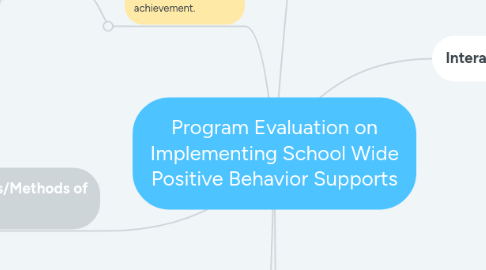
1. The purpose of the Program Evaluation overall is to determine if SWPBIS improves academic achievement.
1.1. Questions
1.1.1. What is the effect of SWPBIS?
1.1.2. How can SWPBIS interventions be improved throughout the implementation of the TCP?
1.1.3. How should District X develop SWPBIS?
2. Evaluation Audience Types/Methods of Communication
2.1. District teachers/ ongoing communication during monthly staff meetings
2.2. District's Board of Education/ 2x year during board meetings
2.3. SWPBIS site teams/during monthly PLC meetings
2.4. Parents/ 2x year through newsletters
2.5. Principals (including assistants) and counselors/ 1x month during leadership meetings
2.6. Support staff (office staff, paraeducators, and office staff)
3. Reference: Program Evaluation Overview (n.d.). Retrieved from https://brandman.blackboard.com/webapps/blackboard/content/listContent.jsp?course_id=_272933_1&content_id=_10381304_1
4. Proactive Evaluation (Clarificative Evaluation)
4.1. Purpose
4.1.1. To help change the way District X addresses student behavior
4.2. Proactive Questions
4.2.1. What are the current national trends in this area?
4.2.2. What are the current laws pertaining to this area?
4.2.3. What are the current evidence-based practices in this area?
4.2.4. Do District X policies and practices align with trends, laws, and research?
4.3. Clarificative Questions
4.3.1. What are the district's policies and practices and how do they need to be improved to align with trends, laws, and research?
4.3.2. What are the TCP objectives and how do they need to be communicated to stakeholders?
4.3.3. What is the program logic and has it been validated?
4.4. Purpose
4.4.1. Develop a strategic plan
5. Interactive Evaluation
5.1. Purpose
5.1.1. To address the inconsistency and lack of alignment throughout elementary through high school
5.1.2. To determine the strengths and weaknesses of the behavioral interventions in place, develop strategies, and make them consistently available throughout the district.
5.2. Questions
5.2.1. Are the interventions effective in reducing the suspension rates by 30%?
5.2.2. Are the staff development activities adequately preparing staff to implement the interventions with at least 80% self-confidence as determined by self-assessment surveys?
6. Monitoring Evaluation (Impact Evaluation)
6.1. Purpose
6.1.1. Assess SWPBIS at three schools
6.2. Monitoring Questions
6.2.1. Are the interventions being implemented with 80% fidelity as measured by SWPBIS walk-through observation forms?
6.3. Impact Questions
6.3.1. Is the impact of SWPBIS on District X student learning significant as measured by a 50% decrease in suspensions and explosions, a 10% increase in student attendance, and 10% increase in student achievement?
6.4. Purpose
6.4.1. Assess the effects of SWPBIS (discipline, attendance, culture/climate of school, and academic achievement
